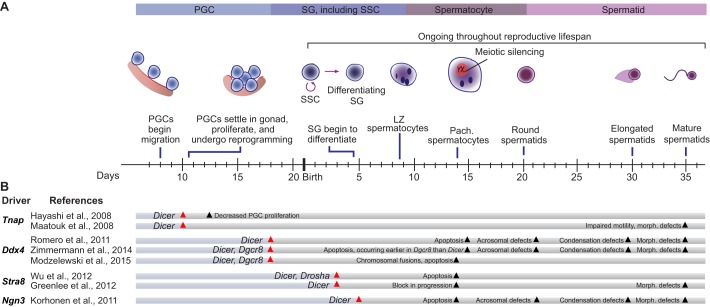Fig. 1.
Spermatogenesis in mice and the effects of Dgcr8, Drosha and Dicer male germline knockout. (A) In male mice, PGCs begin to migrate to the gonad at embryonic day 8 (E8). By E10.5, they settle in the gonad and begin a program of proliferation and reprogramming, eventually becoming spermatogonia (SG). Around postnatal day 4.5 (P4.5), a subset of spermatogonia further differentiate and enter meiosis at P8, becoming spermatocytes. Of the spermatogonia that remain, some serve as SSCs, which replenish the spermatogonial pool for future waves of spermatogenesis. Following completion of meiosis at P20, germ cells (now called round spermatids) undergo morphological changes, including chromatin condensation and cellular elongation, ultimately forming mature spermatids. Following this initial wave of spermatogenesis, the process reoccurs throughout the organism's reproductive lifespan. (B) The conditional knockout of genes encoding small RNA biogenesis factors (Dgcr8, Drosha or Dicer) reveals essential roles for AGO-bound small RNAS during spermatogenesis. Summarized here are studies in which Dgcr8, Drosha or Dicer were conditionally disrupted from the male mouse germline. The promoter driving Cre-mediated disruption in each case is indicated [Tnap (Alpl); Ngn3 (Neurog3)], together with the approximate time of Cre activation (red arrowhead) and the time point at which a phenotype was observed (black arrowhead). Timescale indicates embryonic days up until birth, then postnatal days. LZ, leptotene/zygotene; Morph., morphological; Pach., pachytene.

